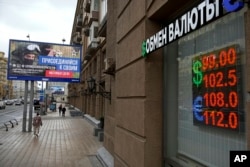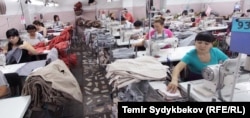BISHKEK -- In an industry based on the principles "cut, make, and trim," margins are tight. But for a growing number of garment manufacturers in Kyrgyzstan, Russia's ailing ruble is making them too tight to bear.
"Businessmen working with Russia place orders and then say, 'Wait -- let the ruble rise a little, the exchange rate is too low for us and we cannot get the profits that we were getting before,'" complained Nurzat Alimurzaeva, an entrepreneur who runs several small sewing shops in the Kyrgyz capital, Bishkek.
"The fall of the [ruble to som] rate has led many sewing shops to close," she told RFE/RL's Kyrgyz Service. "Many people are struggling to recoup their expenditures."
Kyrgyzstan's garment industry employs many tens of thousands of people and has long been a bright spot in an economy low on jobs.
But a strong dependence on top buyer Russia has made it prone to booms and busts, caught between peaks in demand that the industry's workforce struggles to meet and valleys caused by external shocks.
The months that followed Russia's unprovoked, full-scale invasion of Ukraine in February 2022 were mostly boom, with sewing-shop managers forced to outsource orders to seamstresses in different parts of the country to cover a labor shortfall.
Now they find themselves on the other side of the cycle.
The Ruble's Swings
After Moscow's invasion triggered unprecedented sanctions from Western countries, the ruble endured a wild 2022.
Its recovery from a post-invasion fall of more than 30 percent began in March 2022 as Moscow resorted to drastic policies to counter sanctions, while rising commodity prices kept hard currency flowing into the Kremlin's coffers.
But despite peaking at under 53 to the dollar that summer, it ended last year about where it started, at just over 73.5 to the dollar.
Earlier this month, the currency fell to an 18-month low of more than 102 to the dollar, before recovering to the current rate of around 97.
Fearful of socioeconomic dissatisfaction, the governments of some of Russia's closest partners have been digging into reserves to ensure that their respective currencies don't mimic the ruble's plight.
Kyrgyzstan's National Bank carried out more than a dozen interventions this year, equating to more than $650 million used to prop up the som, with two interventions this month alone.
But for textile exporters, a relatively strong som is a losing hand.
"If before we sold clothes valued at 1,000 soms to Russia for 800 to 820 rubles. Now we are asking them for 1,300 rubles," a trader named Aibek, who works out of the Bishkek-based Dordoi market, told RFE/RL's Kyrgyz Service.
"For [Russian businesses], purchasing goods from Kyrgyzstan has become expensive and unprofitable.... It is an awkward [situation] for us and for the Russians," he said, adding that it was "time to search for new markets."
This year the Kyrgyz som has appreciated 27 percent against the ruble, while falling only 5 percent against the dollar.
The long-term health of the Russian currency is in doubt, meanwhile, with the early October dip coming after Russia's Central Bank launched a significant intervention to keep the currency on the right side of the 100-to-the-dollar threshold in August.
Sewing Amid Sanctions
In these circumstances, it is odd that Kyrgyzstan's overall exports -- to Russia in particular -- have been soaring.
Total exports rose 35 percent in the first six months of this year versus the same period last year, with Russia the top destination.
Such anomalous figures have raised eyebrows in Western capitals in the context of so-called "sanctions busting" -- trade with Russia in violation of the U.S.- and EU-led sanctions regime.
An RFE/RL investigation published in June highlighted how companies from Kyrgyzstan and neighboring Kazakhstan exported sanctioned, dual-use technology to Russian suppliers of the Kremlin's war machine. https://www.rferl.org/a/kyrgyz-kazakh-firms-investigation-western-tech-russia-war-ukraine/32467795.html
Kyrgyzstan has also found itself breaking records since the war began for imports and exports of less harmful products that it had no prior history of trading in significant volumes.
The long-term employment benefits of this reexport service are unclear.
The garments industry, by contrast, is a leading employer, accounting for 200,000 people or 8.5 percent of the total work force in 2019, according to the U.S. Trade Administration in 2019.
That makes it something of a bellwether for a Russia-exposed economy, with other important sectors including agriculture and tourism expected to suffer in the medium term.
The first Kyrgyz to feel the weight of the sickly ruble were the hundreds of thousands of migrants working abroad in Russia, whose money transfers home typically equate to more than 30 percent of Kyrgyzstan's GDP.
The only consolation for garment manufacturers is that they have been here before.
From the fall of the Soviet Union through the coronavirus pandemic, the industry has fallen sharply on those occasions before picking itself up again.
In the weeks after Russia invaded Ukraine, orders from Russia basically dropped to zero, only to reach unmanageable levels by the spring of 2022.
A key reason for that, according to a sewing-shop owner interviewed by RFE/RL's Kyrgyz Service in June 2022, was Russia's domestic apparel market "emptying out" as sanctions began to bite.
But now, according to Alimurzaeva, only around 40 percent of a group of 300 sewing-shop owners that she belongs to are reporting new orders.
"The rest are just finishing off older orders," Alimurzaeva said glumly.














